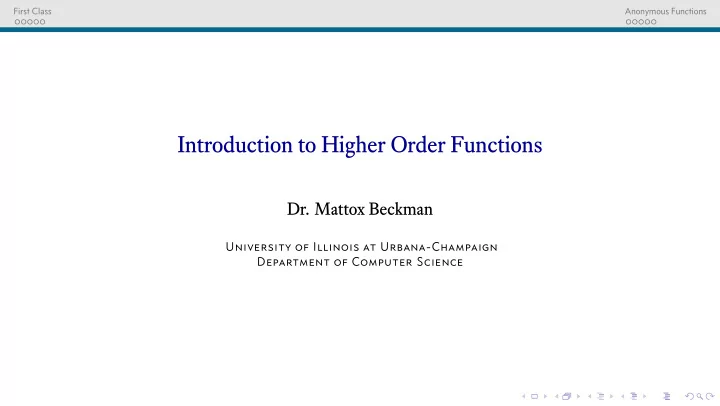

First Class Anonymous Functions Introduction to Higher Order Functions Dr. Mattox Beckman University of Illinois at Urbana-Champaign Department of Computer Science
First Class Anonymous Functions Objectives ◮ Explain the concept of fjrst class citizen . ◮ Use sectioning and lambda to defjne anonymous functions. ◮ Change the behavior and interface of a function by using another function.
First Class Anonymous Functions First Class Functions An entity is said to be fjrst class when it can be: ◮ Assigned to a variable, passed as a parameter, or returned as a result Examples: ◮ APL : scalars, vectors, arrays ◮ C : scalars, pointers, structures ◮ C++ : like C , but with objects ◮ Haskell , Lisp , OCaml : scalars, lists, tuples, functions The Kind of Data a Program Manipulates Changes the Expressive Ability of a Program.
First Class Anonymous Functions Defjning Functions the Usual Way Some Haskell Functions 1 sqr a = a * a 2 hypotsq a b = sqr a + sqr b Sample Run 1 sqr :: Integer -> Integer 2 sqr :: Num a => a -> a 3 hypotsq :: Num a => a -> a -> a 4 Prelude> sqr 10 5 100 6 Prelude> hypotsq 3 4 7 25
g f First Class Anonymous Functions Example: Compose Example 1 inc x = x + 1 2 double x = x * 2 3 compose f g x = f (g x) ◮ Notice the function types. 1 compose :: (t1 -> t2) -> (t -> t1) -> t -> t2 2 Prelude> : t double 3 double :: Integer -> Integer 4 Prelude> double 10 5 20 6 Prelude> compose inc double 10 7 21
Prelude> :t twice twice :: (t -> t) -> t -> t Prelude> twice inc 5 7 Prelude> twice twice inc 4 First Class Anonymous Functions Example: Twice ◮ One handy function allows us to do something twice. ◮ You will see this function again! Twice 1 twice f x = f (f x) Here is a sample run …
First Class Anonymous Functions Creating Functions: Lambda Form ◮ Functions do not have to have names. 1 \ x -> x + 1 ◮ The parts: ◮ Backslash (a.k.a. lambda ) ◮ Parameter list ◮ Arrow ◮ Body of function 1 prelude> ( \ x -> x + 1) 41 2 42
First Class Anonymous Functions Creating Functions: Partial Application Standard Form vs. Anonymous Form 1 inc :: ( Num t) => t -> t 2 inc a = a + 1 3 inc = \ a -> a + 1 4 5 plus :: ( Num t) => t -> t -> t 6 plus a b = a + b 7 plus = \ a -> \ b -> a + b ◮ What do you think we would get if we called plus 1 ?
First Class Anonymous Functions Creating Functions: Partial Application Standard Form vs. Anonymous Form 1 inc :: ( Num t) => t -> t 2 inc a = a + 1 3 inc = \ a -> a + 1 4 5 plus :: ( Num t) => t -> t -> t 6 plus a b = a + b 7 plus = \ a -> \ b -> a + b ◮ What do you think we would get if we called plus 1 ? 1 inc = plus 1
First Class Anonymous Functions η -equivalence An Equivalence f ≡ \x -> f x ◮ Proof, assuming f is a function… f z ≡ (\x -> f x) z These are Equivalent So are These 1 inc x = x + 1 1 plus a b = ( + ) a b 2 plus a = ( + ) a 2 inc = ( + ) 1 3 inc = ( + 1) 3 plus = ( + )
First Class Anonymous Functions Curry and Uncurry ◮ Suppose you have a function tplus that takes a pair of integers and adds them. 1 tplus :: ( Integer , Integer ) -> Integer 2 tplus (a,b) = a + b ◮ But you really wish it took its arguments one at a time. ◮ There’s a function curry :: (a,b) -> c -> a -> b -> c that will convert it for you! See if you can write it.
Recommend
More recommend